Is the influence of an exceptional vineyard diminished when the wine isn’t given enough time to develop to its full potential?
These are questions raised by the decision of Gut Hermannsberg, in Germany’s Nahe Valley, to postpone the release of its single-vineyard Kupfergrube Riesling until it has undergone five years of ageing.
Why five years?
Gut Hermannsberg’s CEO, Achim Kirchner, told Canopy: “We now release our top dry Rieslings from the legendary Kupfergrube vineyard site as a GG (Großes Gewächs) Reserve five years after the harvest. The decision to switch from release at two years of age to five was based on our experience with earlier vintages.”This experience shows it takes at least five years for wines from the Kupfergrube (below) – where they own 12ha – to unfurl their complex aromatics.
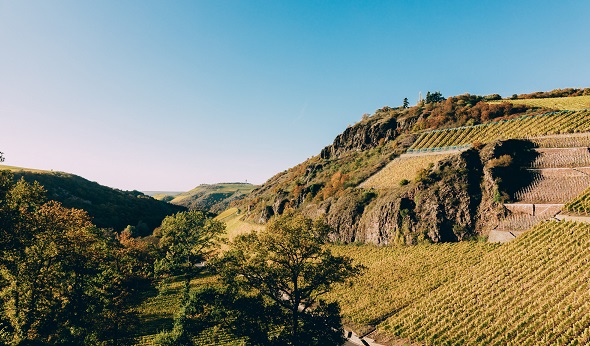
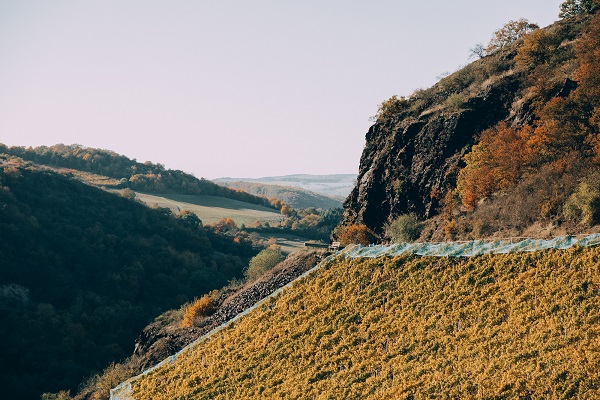
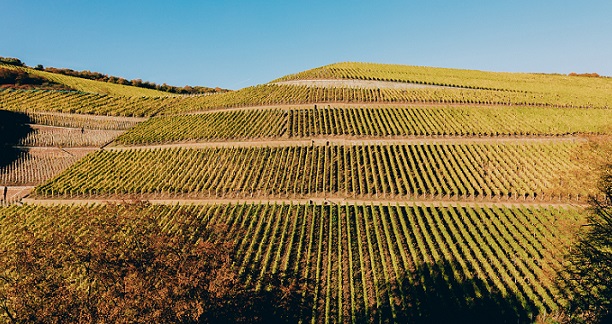
Winemaker Karsten Peter believes that two years is too soon to taste and judge this wine, and that the extra time is well worth the wait.
So, in 2017, Achim, Karsten and fellow general manager Jasper Reidel (below) decided to permanently push back the market release of their flagship wine, the Kupfergrube Riesling Großes Gewächs.

But a major transition like this doesn’t happen overnight. A transition phase was required, meaning only small amounts of the Kupfergrube 2015 and 2016 were released after two years. The majority was held in reserve, deep in the estate’s historic cellars, created in 1902 by the Prussian government and purchased in 2009 by Jens Reidel and Dr Christine Dinse.
The 2015 Kupfergrube GG Reserve, which comes entirely from old vines (30-70 years old) growing on the six massive terraces at the core of the vineyard, has now been re-released, and the 2016 will be re-released in September 2021. The 2017 will mark the first vintage to be presented in its entirety five years after harvest, when it is released in September 2022.
With the full release of the 2015 vintage this month, it seemed a good time to quiz Gut Hermannsberg’s CEO about the importance of time in the idea of terroir.
'You can compare our dry Riesling GGs to a special sauce'
Canopy: How important is time in the concept of terroir?
Achim Kirchner: “99% of modern white wines should be drunk right away, but dry Riesling GGs from ‘grand cru’ terroirs belong to the 1% that have as much ageing potential as any of the great reds on Planet Wine. You can compare our dry Riesling GGs to a special sauce that a top chef prepares. He could knock out a tasty sauce rather quickly using cheap ingredients, but to make a really delicious one he must use only the best ingredients and it takes several days.
“Easy-drinking wines are professionally made winemaker-wines, and they’re ready for consumption from the moment they go into the bottle. Our entry-level dry ‘Just Riesling!’ also belongs to this category. In contrast, our GGs only develop their full complexity and harmony through further ageing in bottle. We refer to this potential that slowly unfurls with time as the Third Dimension of Wine. The best thing is to put a number of bottles of one (or more) of our GGs in the cellar so that you can enjoy following the wine’s development over years, or even decades.”
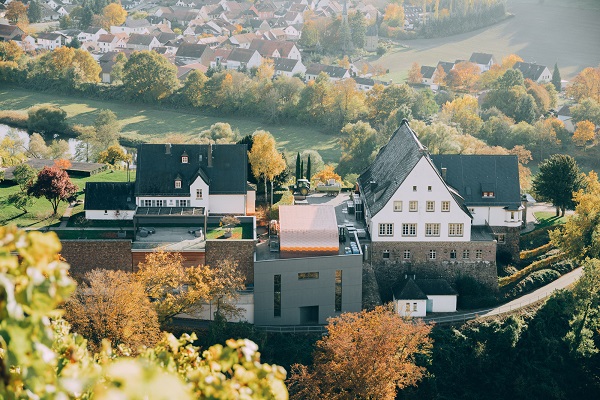
What is the role of time in terroir?
AK: “It has many sides! Along with the Hermannsberg, the steep and terraced Kupfergrube is the most famous of Gut Hermannsberg’s seven terroirs, or GG/grand cru sites. When the estate was founded as the Royal Prussian Domain in 1902, a great many climate and soil tests were done to find the perfect location for new vineyards. Where the Kupfergrube stands today there were only volcanic cliffs, stunted oaks and an abandoned copper mine (the name is copper mine in German), so the decision to create a new terroir there was very daring and the construction work very time-consuming. The first vintage was 1910!
“The Kupfergrube has a shallow and stony volcanic melaphry soil that’s very rare on Planet Wine. The interaction between the vines and the soil, also the microbial life of the soil, is still being researched. Although we cannot yet precisely explain it, experience teaches us that the Kupfergrube wines always have a special smoky, grapefruit and mineral character that slowly develops over years and decades.
“Every great wine has its own ageing curve. For example, the 2016 Hermannsberg GG (delicious now and with many years ahead of it) isn’t comparable with the 2018 Hermannsberg GG (only just beginning to go through its paces, but with decades of ageing potential). Although our climate warmed during the last decades, like everywhere else, climate change hasn’t altered vintage variation. And the GG from each of our seven terroirs ages in its own completely distinctive way.”
‘Time is our most important winemaking tool’Should more winemakers consider time part of terroir?
AK: “We are convinced that great wines must be vinified very cautiously and without any haste, gently guiding the natural processes in order to maximize the expression of terroir. At Gut Hermannsberg this means long skin-contact of the grapes to extract aromas, minerals and tannins from the skins in a similar way to red winemaking, but before the alcoholic fermentation begins. We need the tannins to harmonise the pronounced acidity typical for all of our dry Rieslings. The same is true of the wines’ long ageing on the lees in cask, which for the GGs last between one to two years. All the wines from our 30 hectares (74 acres) of vineyards are wild fermented and we don’t fine them either. We prefer to let time deal with potential instability problems in the natural way. Time is our most important winemaking tool.”

In white winemaking, is this approach only appropriate for Riesling?
AK: “Patience is absolutely essential for terroir regardless of the grape variety!”
How has the opportunity to taste wines back to 1914 and the legendary 1921 influenced your decision to push back the release of your flagship wine?
AK: “Whenever we do a vertical tasting of the GGs from the Kupfergrube or Hermannsberg (the monopole holding after which the company takes its name), then we always come to the same conclusion: the older the wines are, the better they taste. Five years is really only just the beginning! When asked, we always recommend more ageing than that. How much? We’re cautious, but don’t want to underestimate their ageing potential. Just a few days ago we tasted a 1949 Kupfergrube with a group of journalists and top sommeliers. They all agreed that it tasted unbelievably fresh and complex.
“The principal of giving great Riesling wines long ageing before release was normal in Germany into the early 1970s. It was the arrival of modern cellar technology that abolished this by accelerating the clarification and maturation processes. So, we and some other top German producers are now returning to that tradition. Perhaps some people will say that we are old-fashioned, but we all think it’s simply the best way for the quality and character of the wines.”
‘Perhaps some people will say that we are old-fashioned, but we all think it’s simply the best way for the quality and character of the wines’


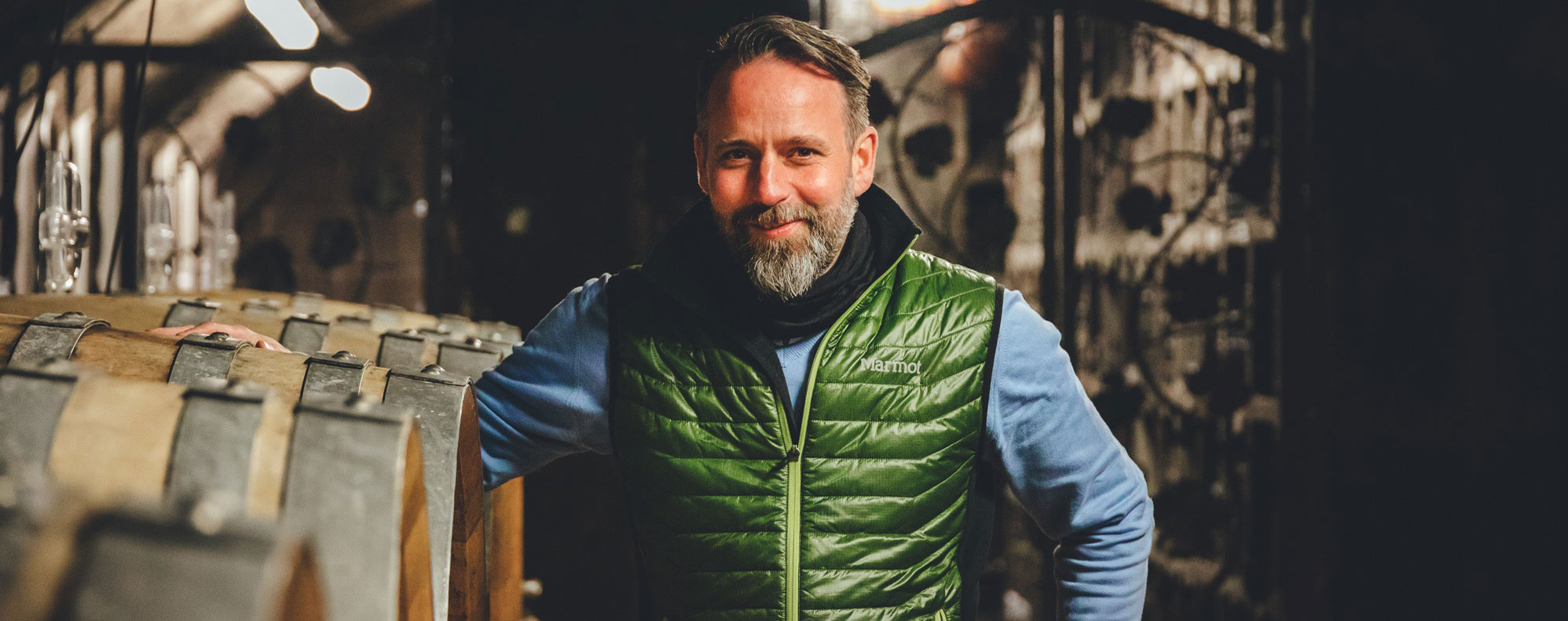










.png)






